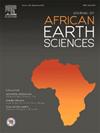Petrogenesis and geodynamic model for (Ta, Nb)-fertilized Nuweibi albite granite, Egyptian Nubian Shield: Juvenile crust-mantle mixing and metasomatic enhancement
IF 2.2
4区 地球科学
Q2 GEOSCIENCES, MULTIDISCIPLINARY
引用次数: 0
Abstract
Nuweibi Albite Granite (NAG, 1.3 km2 as total area) is considered one of the well-known highly evolved, rare metals-bearing pluton in the Egyptian Nubian Shield. The Nuweibi area constitutes ophiolite assemblage (metagabbros, serpentinites and related talc-carbonates), tuffaceous metasediments with their associated hornfelse, granodiorite-tonalite and post-tectonic albite granite, the latter is cross cutting by aplite and basaltic dykes. The present work focuses on the geochemical characteristic of NAG, using new data of whole-rock geochemistry and mineral chemistry to address-out approach on its origin, geodynamic evolution and genetic relation with the Ta-Nb mineralization. The main (Ta, Nb)-bearing minerals include; tantalite, columbite, wodginite and calciomicrolite. The geochemical analyses revealed that, the studied NAG has peraluminous, within-plate, post-collisional, A-type characters. It exhibits an enrichment of Na2O (up to 6.56 wt%) reflecting the alkaline affinity (σ up to 6.19), closing to alkaline trend of an extensional regime. The REEs tetrad effect is well pronounced with negative Eu anomaly, which is most remarkable toward the closing of magma at the late magmatic stage of fractionation. The analytical criteria support the evolution of NAG through highly evolved magmatic fractionation (in major) and later metasomatic replacement (in minor). The abundance of rare metals such as (Ta, Nb), suggests the strong influence of fluorine and aqueous fluid system in the residual melt. With respect to the magmatic origin of NAG through advanced degree of fractionation, a complex set of geological processes including crust-mantle mixing, partial melting and fluid flux-volatiles interaction (i.e. metasomatism) have been involved during the geodynamic evolution.
求助全文
约1分钟内获得全文
求助全文
来源期刊

Journal of African Earth Sciences
地学-地球科学综合
CiteScore
4.70
自引率
4.30%
发文量
240
审稿时长
12 months
期刊介绍:
The Journal of African Earth Sciences sees itself as the prime geological journal for all aspects of the Earth Sciences about the African plate. Papers dealing with peripheral areas are welcome if they demonstrate a tight link with Africa.
The Journal publishes high quality, peer-reviewed scientific papers. It is devoted primarily to research papers but short communications relating to new developments of broad interest, reviews and book reviews will also be considered. Papers must have international appeal and should present work of more regional than local significance and dealing with well identified and justified scientific questions. Specialised technical papers, analytical or exploration reports must be avoided. Papers on applied geology should preferably be linked to such core disciplines and must be addressed to a more general geoscientific audience.
 求助内容:
求助内容: 应助结果提醒方式:
应助结果提醒方式:


